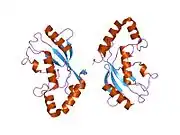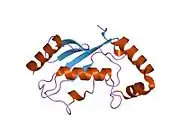UBE2L6
Ubiquitin/ISG15-conjugating enzyme E2 L6 is a protein that in humans is encoded by the UBE2L6 gene.[5][6]
| UBE2L6 | |||||||||||||||||||||||||||||||||||||||||||||||||||
|---|---|---|---|---|---|---|---|---|---|---|---|---|---|---|---|---|---|---|---|---|---|---|---|---|---|---|---|---|---|---|---|---|---|---|---|---|---|---|---|---|---|---|---|---|---|---|---|---|---|---|---|
 | |||||||||||||||||||||||||||||||||||||||||||||||||||
| |||||||||||||||||||||||||||||||||||||||||||||||||||
| Identifiers | |||||||||||||||||||||||||||||||||||||||||||||||||||
| Aliases | UBE2L6, RIG-B, UBCH8, ubiquitin conjugating enzyme E2 L6 | ||||||||||||||||||||||||||||||||||||||||||||||||||
| External IDs | OMIM: 603890 MGI: 1914500 HomoloGene: 3112 GeneCards: UBE2L6 | ||||||||||||||||||||||||||||||||||||||||||||||||||
| |||||||||||||||||||||||||||||||||||||||||||||||||||
| |||||||||||||||||||||||||||||||||||||||||||||||||||
| |||||||||||||||||||||||||||||||||||||||||||||||||||
| |||||||||||||||||||||||||||||||||||||||||||||||||||
| |||||||||||||||||||||||||||||||||||||||||||||||||||
| Wikidata | |||||||||||||||||||||||||||||||||||||||||||||||||||
| |||||||||||||||||||||||||||||||||||||||||||||||||||
The modification of proteins with ubiquitin is an important cellular mechanism for targeting abnormal or short-lived proteins for degradation. Ubiquitination involves at least three classes of enzymes: ubiquitin-activating enzymes (E1S), ubiquitin-conjugating enzymes (E2S) and ubiquitin-protein ligases (E3s). This gene encodes a member of the E2 ubiquitin-conjugating enzyme family.
This enzyme is highly similar in primary structure to the enzyme encoded by UBE2L3 gene. Two alternatively spliced transcript variants encoding distinct isoforms have been found for this gene.[6]
References
- GRCh38: Ensembl release 89: ENSG00000156587 - Ensembl, May 2017
- GRCm38: Ensembl release 89: ENSMUSG00000027078 - Ensembl, May 2017
- "Human PubMed Reference:". National Center for Biotechnology Information, U.S. National Library of Medicine.
- "Mouse PubMed Reference:". National Center for Biotechnology Information, U.S. National Library of Medicine.
- Kumar S, Kao WH, Howley PM (Jul 1997). "Physical interaction between specific E2 and Hect E3 enzymes determines functional cooperativity". J Biol Chem. 272 (21): 13548–54. doi:10.1074/jbc.272.21.13548. PMID 9153201.
- "Entrez Gene: UBE2L6 ubiquitin-conjugating enzyme E2L 6".
Further reading
- Kang HY, Yeh S, Fujimoto N, Chang C (1999). "Cloning and characterization of human prostate coactivator ARA54, a novel protein that associates with the androgen receptor". J. Biol. Chem. 274 (13): 8570–6. doi:10.1074/jbc.274.13.8570. PMID 10085091.
- Moynihan TP, Ardley HC, Nuber U, et al. (1999). "The ubiquitin-conjugating enzymes UbcH7 and UbcH8 interact with RING finger/IBR motif-containing domains of HHARI and H7-AP1". J. Biol. Chem. 274 (43): 30963–8. doi:10.1074/jbc.274.43.30963. PMID 10521492.
- Huang L, Kinnucan E, Wang G, et al. (1999). "Structure of an E6AP-UbcH7 complex: insights into ubiquitination by the E2-E3 enzyme cascade". Science. 286 (5443): 1321–6. doi:10.1126/science.286.5443.1321. PMID 10558980.
- Nyman TA, Matikainen S, Sareneva T, et al. (2000). "Proteome analysis reveals ubiquitin-conjugating enzymes to be a new family of interferon-alpha-regulated genes". Eur. J. Biochem. 267 (13): 4011–9. doi:10.1046/j.1432-1327.2000.01433.x. PMID 10866800.
- Ardley HC, Rose SA, Tan N, et al. (2000). "Genomic organization of the human ubiquitin-conjugating enzyme gene, UBE2L6 on chromosome 11q12". Cytogenet. Cell Genet. 89 (1–2): 137–40. doi:10.1159/000015593. PMID 10894956. S2CID 502452.
- Zhang Y, Gao J, Chung KK, et al. (2001). "Parkin functions as an E2-dependent ubiquitin- protein ligase and promotes the degradation of the synaptic vesicle-associated protein, CDCrel-1". Proc. Natl. Acad. Sci. U.S.A. 97 (24): 13354–9. doi:10.1073/pnas.240347797. PMC 27228. PMID 11078524.
- Niwa J, Ishigaki S, Doyu M, et al. (2001). "A novel centrosomal ring-finger protein, dorfin, mediates ubiquitin ligase activity". Biochem. Biophys. Res. Commun. 281 (3): 706–13. doi:10.1006/bbrc.2001.4414. PMID 11237715.
- Wheeler TC, Chin LS, Li Y, et al. (2002). "Regulation of synaptophysin degradation by mammalian homologues of seven in absentia". J. Biol. Chem. 277 (12): 10273–82. doi:10.1074/jbc.M107857200. PMID 11786535.
- Urano T, Saito T, Tsukui T, et al. (2002). "Efp targets 14-3-3 sigma for proteolysis and promotes breast tumour growth". Nature. 417 (6891): 871–5. Bibcode:2002Natur.417..871U. doi:10.1038/nature00826. PMID 12075357. S2CID 4348545.
- Chin LS, Vavalle JP, Li L (2002). "Staring, a novel E3 ubiquitin-protein ligase that targets syntaxin 1 for degradation". J. Biol. Chem. 277 (38): 35071–9. doi:10.1074/jbc.M203300200. PMID 12121982.
- Strausberg RL, Feingold EA, Grouse LH, et al. (2003). "Generation and initial analysis of more than 15,000 full-length human and mouse cDNA sequences". Proc. Natl. Acad. Sci. U.S.A. 99 (26): 16899–903. Bibcode:2002PNAS...9916899M. doi:10.1073/pnas.242603899. PMC 139241. PMID 12477932.
- Ota T, Suzuki Y, Nishikawa T, et al. (2004). "Complete sequencing and characterization of 21,243 full-length human cDNAs". Nat. Genet. 36 (1): 40–5. doi:10.1038/ng1285. PMID 14702039.
- Chuang TH, Ulevitch RJ (2004). "Triad3A, an E3 ubiquitin-protein ligase regulating Toll-like receptors". Nat. Immunol. 5 (5): 495–502. doi:10.1038/ni1066. PMID 15107846. S2CID 39773935.
- Zhao C, Beaudenon SL, Kelley ML, et al. (2004). "The UbcH8 ubiquitin E2 enzyme is also the E2 enzyme for ISG15, an IFN-alpha/beta-induced ubiquitin-like protein". Proc. Natl. Acad. Sci. U.S.A. 101 (20): 7578–82. Bibcode:2004PNAS..101.7578Z. doi:10.1073/pnas.0402528101. PMC 419648. PMID 15131269.
- Tripathi MK, Chaudhuri G (2005). "Down-regulation of UCRP and UBE2L6 in BRCA2 knocked-down human breast cells". Biochem. Biophys. Res. Commun. 328 (1): 43–8. doi:10.1016/j.bbrc.2004.12.142. PMC 3085986. PMID 15670748.
- Rual JF, Venkatesan K, Hao T, et al. (2005). "Towards a proteome-scale map of the human protein-protein interaction network". Nature. 437 (7062): 1173–8. Bibcode:2005Natur.437.1173R. doi:10.1038/nature04209. PMID 16189514. S2CID 4427026.
- Li J, Wang J, Yang X, et al. (2007). "The Spen homolog Msx2-interacting nuclear target protein interacts with the E2 ubiquitin-conjugating enzyme UbcH8". Mol. Cell. Biochem. 288 (1–2): 151–7. doi:10.1007/s11010-006-9131-9. PMID 16583136. S2CID 24935755.
This article is issued from Wikipedia. The text is licensed under Creative Commons - Attribution - Sharealike. Additional terms may apply for the media files.







